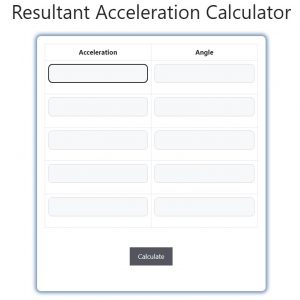About Resultant Acceleration Calculator (Formula)
The Resultant Acceleration Calculator is a crucial tool for engineers, physicists, and students who need to analyze motion involving multiple acceleration vectors. When dealing with objects that experience different accelerations in various directions, calculating the resultant acceleration becomes essential for understanding their overall motion. This article will discuss the formula for calculating resultant acceleration, explain how to use the calculator, provide an example, and answer frequently asked questions.
Formula
The formulas for calculating the components and magnitude of resultant acceleration are as follows:
- For the x-component of acceleration (Ax):
Ax = A1 * cos(a1) + A2 * cos(a2) + …
- For the y-component of acceleration (Ay):
Ay = A1 * sin(a1) + A2 * sin(a2) + …
- For the magnitude of the resultant acceleration (Amag):
Amag = SQRT(Vx² + Vy²)
Where:
- A1, A2, … are the magnitudes of the individual accelerations.
- a1, a2, … are the angles corresponding to each acceleration.
- Vx and Vy are the resultant components in the x and y directions, respectively.
How to Use
To use the Resultant Acceleration Calculator, follow these steps:
- Identify the Acceleration Vectors: Determine the magnitudes and directions (angles) of all individual acceleration vectors acting on the object.
- Input Values: Enter the magnitudes and angles of each acceleration vector into the calculator.
- Calculate Components: The calculator will compute the x and y components (Ax and Ay) using the cosine and sine functions, respectively.
- Calculate Resultant Magnitude: Finally, it will calculate the magnitude of the resultant acceleration using the formula provided.
Example
Consider an object experiencing two acceleration vectors:
- A1 = 10 m/s² at an angle a1 = 30 degrees
- A2 = 5 m/s² at an angle a2 = 120 degrees
To find the resultant acceleration:
- Calculate Ax:
- Ax = 10 * cos(30°) + 5 * cos(120°)
- Ax ≈ 10 * 0.866 + 5 * (-0.5)
- Ax ≈ 8.66 – 2.5 = 6.16 m/s²
- Calculate Ay:
- Ay = 10 * sin(30°) + 5 * sin(120°)
- Ay ≈ 10 * 0.5 + 5 * (0.866)
- Ay ≈ 5 + 4.33 = 9.33 m/s²
- Calculate the magnitude:
- Amag = SQRT(6.16² + 9.33²)
- Amag ≈ SQRT(37.98 + 87.07) = SQRT(125.05) ≈ 11.18 m/s²
Thus, the resultant acceleration is approximately 11.18 m/s².

FAQs
- What is resultant acceleration?
- Resultant acceleration is the overall acceleration of an object when multiple acceleration vectors are acting on it.
- Why is calculating resultant acceleration important?
- It helps in analyzing the motion of objects under multiple forces, allowing for better predictions of their movement.
- What units are used for measuring acceleration?
- Acceleration is typically measured in meters per second squared (m/s²).
- Can I use this calculator for three or more acceleration vectors?
- Yes, you can add as many acceleration vectors as needed to calculate the resultant acceleration.
- What do the angles represent in the formulas?
- The angles represent the direction of each acceleration vector relative to a reference direction, usually the positive x-axis.
- How can I find the angle if I only have the components?
- You can use the inverse tangent function: angle = atan(Vy / Vx).
- What happens if the vectors point in opposite directions?
- If vectors point in opposite directions, their magnitudes will partially or completely cancel out in the resultant calculation.
- Can resultant acceleration be negative?
- Yes, if the resultant vector points in the opposite direction of the reference direction, its magnitude will be considered negative.
- What is the significance of the resultant acceleration’s magnitude?
- The magnitude indicates how fast an object will change its velocity as a result of the combined accelerations.
- How can I ensure accurate measurements when using this calculator?
- Ensure you use precise values for acceleration magnitudes and angles, and double-check your calculations.
- Is this calculator applicable in real-life scenarios?
- Yes, it is widely used in physics, engineering, and various fields that involve motion analysis.
- Can I calculate resultant acceleration without angles?
- No, angles are necessary to determine the direction of each acceleration vector.
- What types of problems can this calculator help solve?
- It can help with problems involving projectile motion, vehicle dynamics, and any scenario where multiple accelerations act on an object.
- How does the calculator handle different units?
- Ensure that all acceleration values are in the same unit system (e.g., all in m/s²) for accurate results.
- What should I do if I have acceleration values in different units?
- Convert all values to the same unit system before entering them into the calculator.
- Can this calculator be used for rotational motion?
- The calculator is primarily for linear motion; other formulas apply to rotational motion.
- How does air resistance affect resultant acceleration?
- Air resistance can act as an additional force that alters the effective acceleration acting on an object.
- What tools are available to help visualize resultant acceleration?
- Vector diagrams and software simulations can provide visual representations of resultant acceleration.
- Is this calculator useful for sports physics?
- Absolutely! It can help analyze athlete performance and optimize training strategies based on motion analysis.
- How often should I practice calculating resultant acceleration?
- Regular practice can improve your understanding of motion analysis, particularly if you’re studying physics or engineering.
Conclusion
The Resultant Acceleration Calculator is a powerful tool for understanding the combined effects of multiple acceleration vectors on an object’s motion. By accurately calculating the resultant acceleration, you can gain insights into how different forces interact and influence movement. Whether you’re a student, engineer, or hobbyist, mastering this concept is essential for effective motion analysis in various applications.
